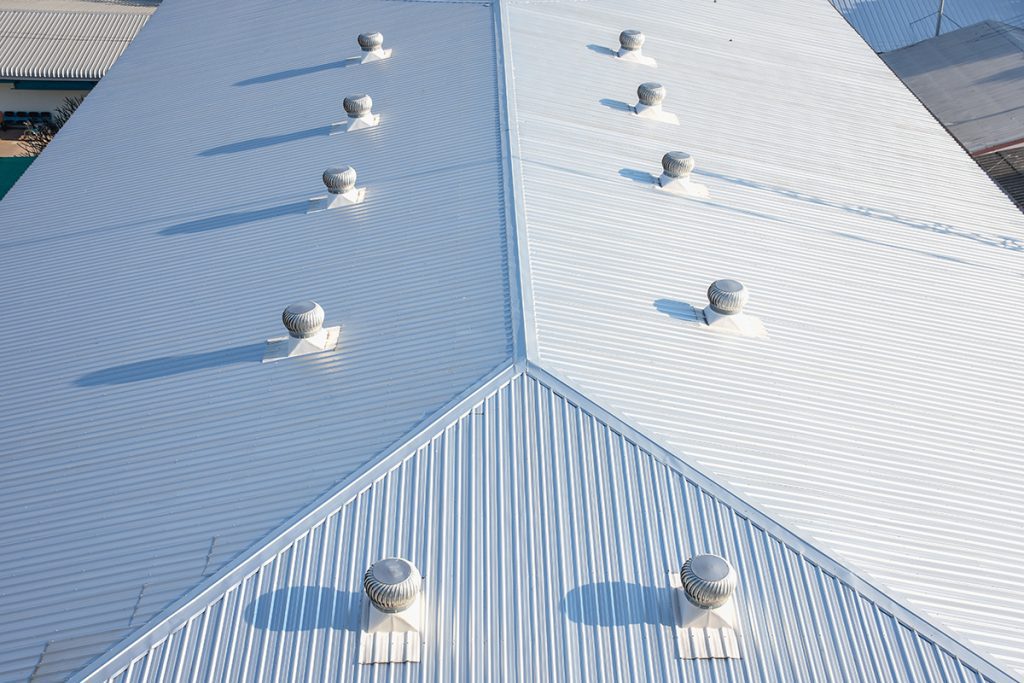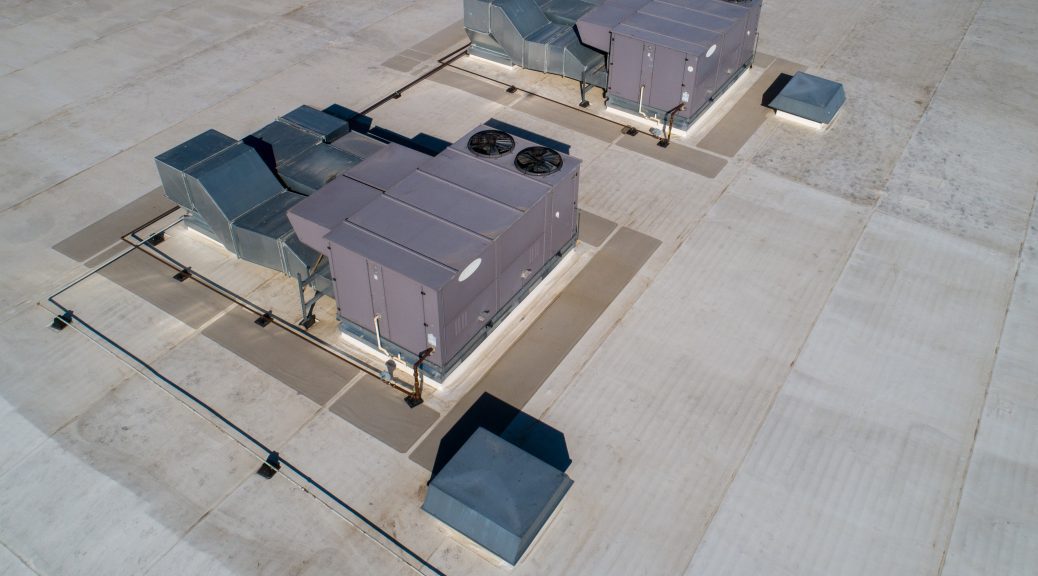If you are building a new commercial building or are preparing to remodel your current one, you have a critical decision to make: What roofing materials will you use? Nearly a dozen materials are commonly used for commercial buildings, making it overwhelming to choose the right one for you.
This is why we have put together a commercial roofing material comparison list to help you organize and understand the differences between roofing systems. If you still have questions after reviewing this list, don’t hesitate to reach out and get our professional opinion!
Shape of Commercial Roofs
Roofing systems can be broadly categorized into low-slope or steep-slope. A commercial roofing system is typically a low-sloped roof but can be steep-sloped depending on the building and zoning. The shape of your roof will depend on the location, the building’s purpose, and other considerations.
Low slope roofs

Most people recognize low-slope roofs as ‘flat roofs.’ A roof system is never truly flat, as this would lead to pooling water and other drainage issues. Low-slope roofs are very useful for warehouses, big box stores, shopping centers, and other large-scale commercial buildings. Flat roofing is typically more accessible for large HVAC units and other rooftop equipment. Flat roof types include EPDM, PVC, and TPO roofing materials.
Steep slope roofs
Steep-slope roofing materials include metal roofing, slate, tile, and traditional asphalt shingles. Small commercial buildings often resemble residential buildings. However, many commercial roof types and materials have different needs and requirements from residential roofs.
Types of Commercial Roofing Materials
Because commercial roofing systems are typically low-sloped roofs, this list will begin with materials that are more suited to this roof shape. Here is your low-slope commercial roofing material comparison:
TPO
One of the most common low-slope roof systems in America, Thermoplastic Polyolefin (TPO), consists of a single rubber membrane layer, typically a polypropylene polymer and ethylene-propylene. This roofing material is very reflective and efficient for your building’s energy costs.
The primary benefits of TPO are the low cost and ease of installation, which make it an extremely economical choice. Additionally, TPO can be made in several colors to match your building’s appearance and aesthetic needs.
PVC

Polyvinyl chloride (PVC) is one of the world’s most commonly produced polymers and is an extremely useful commercial roofing material. PVC roofing systems use two layers of PVC with a layer of reinforcement between them. This simple construction makes it relatively easy to install but also means it doesn’t insulate like other roofing materials.
Thanks to its reusable nature, PVC roofing is durable, fire-resistant, and more eco-friendly. Damaged membranes can be recycled to create a new batch of roofing.
EPDM Roofing
EPDM stands for ethylene propylene diene monomer, a compound that is elastic, durable, and low cost. This synthetic rubber roofing system is created from natural gas and oil products. This material works well against the elements and balances many roof needs well.
The primary drawback is that this material is made primarily from oil, making it far from eco-friendly. However, the additional lifespan and strength make it popular for commercial building owners.
Built-Up Roofing
BUR systems are created by layering upwards of five layers of materials on a roof. This process is a much more intensive installation than other commercial roofing types but results in a very well-insulated building. This trait is very useful for locations that experience various weather conditions from winter to summer.
This roofing system has been used for nearly a century and can be seen as a sort of ‘old reliable’ material. It will not last as long as others, but it will suit nearly any low-slope roofed building.
Cedar Tile Roofing systems
Tile roofing systems are more common in the southwest and arid locations but have slowly spread nationwide thanks to their sharp appearance. Tile roofing systems come in many styles today and have many pros: long life, resistance to fire, rot, insects, and is environmentally friendly. Wooden tiles are typically very good for insulation as well.
However, tile is a very fragile material. More care is taken during installation, leading to slower processes. While tile is designed to resist the elements, larger hail, and falling branches can lead to more expensive repairs.
Slate Roofing systems
Slate is among the longest-lived roofing systems. It isn’t uncommon to see a slate roof that is older than most of a home’s residents. Slate is environmentally friendly in addition to being insect, rot, and fire resistant, and has a sharp aesthetic.
But slate is incredibly heavy, requiring a building to be reinforced or built specifically to support the additional weight. These roofing systems are also much more expensive than typical systems.
Metal Roofing

Metal roofs are a unique material in roofing systems as they are used in both low-slow and steep-slope roofing systems. The smooth appearance and flexibility of metal roofing are only outdone by its long lifespan. Many metal roofing systems are made, including corrugated galvanized steel, Aluminum, stainless steel, and copper.
However, metal roofing does have major drawbacks that prevent it from being an easy first choice: Noise, cost, and weakness to weather damage. Rain and hail will rattle loudly against a metal roof, the initial installation cost is high, and hail and wind can damage metal roofing.
This list is not a complete list of all commercial roofing materials. Still, it is a great overview of the most common and useful materials to consider for your commercial roofing project. Reach out to our professional roofers for more information and to get an estimate on the project you have in mind.
What to Consider When Choosing a Roofing Material?
Now that you’ve seen our commercial roofing material comparison, how do you choose the right material for your roofing system? Every commercial property or building is unique, and everyone has different preferences. That said, there are a few major facets to consider when you are looking to replace, install, or construct a new building’s roofing system.

Cost
The raw cost of materials should be the primary focus, but you should also consider the cost of installation and future repairs. Some roofing systems require specific foundations and higher initial installation costs.

Durability
Weather and nearby trees threaten the health of your roofing membrane. If you live in an area prone to heavy wind, hail, or falling tree branches, you should consider more durable roofing systems.

Lifespan
Durability can factor into the lifespan, but some roofing systems will fare better against typical wear and erosion. Your business might last as long as you live, and your roofing systems should last at least as long.

Insulation
Heat rises, which means your roofing is a major area of temperature transfer. Insulation is a major saving to your energy bill and should be a part of what you consider for your new commercial rooftop.
These four considerations are key to enjoying a commercial roof system that suits your needs. Your building’s health and longevity will rely upon this roofing system, so take careful consideration and work closely with your roofing contractor to find the perfect fit!
Call Heidler Roofing for Help with Your Commercial Roofing Material Comparison
Don’t be overwhelmed by roofing material options – a commercial roofing system needs to be energy efficient, durable, and have a long lifespan. Roofing materials are designed to prioritize these in different ways while balancing costs. For your next commercial roofing project, take the time to really consider your building’s essential needs.
Building owners don’t often think about their commercial roofing system – at least when it works well. So, after our commercial roofing material comparison, we hope that you have a better idea of what you are looking for in the end results of your commercial roofing project. Call us today, and we’ll discuss how we can make your vision a reality!


